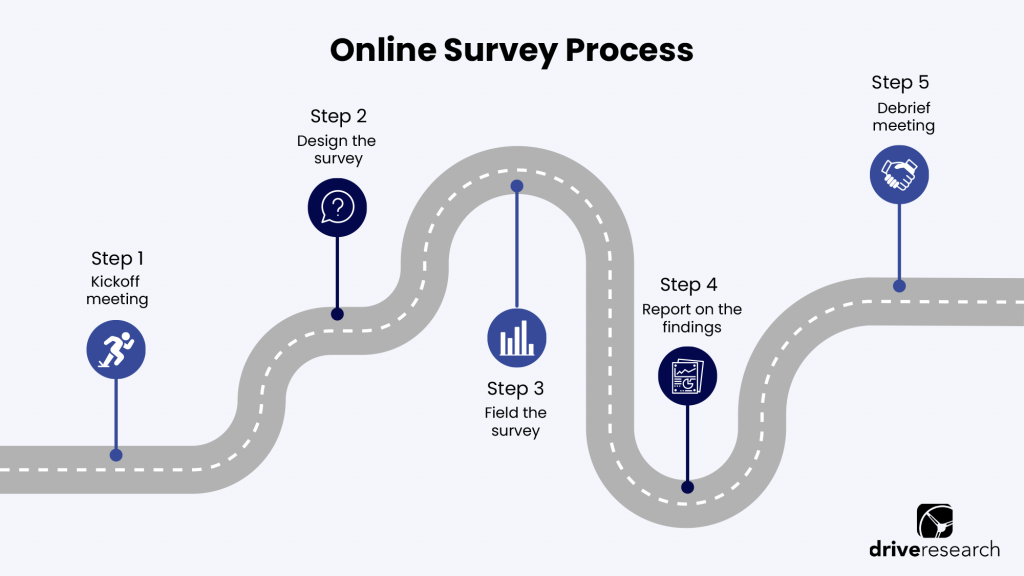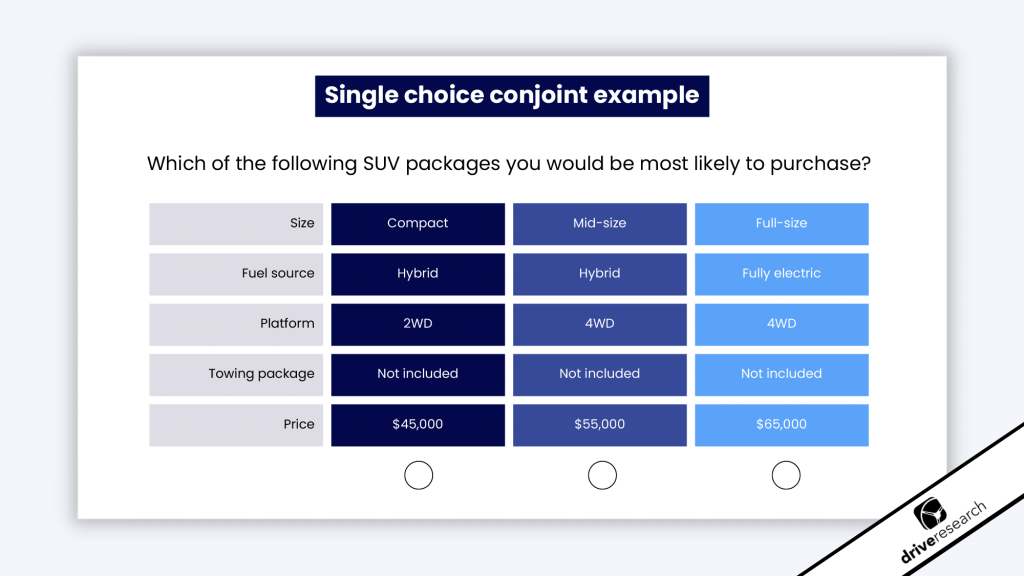
Determining a fair price for your product or service is easier said than done. Why? Because there are several internal and external factors that can influence your decision.
And on top of that, you always need to be thinking of pricing from the consumer’s point of view.
Take the concept of extra costs at checkout for online shoppers. This issue, for example, causes 48% of cart abandonment in online stores.
Fortunately, conducting an online pricing survey can help you determine a precise range or number to increase revenue while maintaining profitability.
Below, our online survey company discusses more about online pricing surveys: what they are, why they are important, how to run one, and key questions to include.
What is an Online Pricing Survey?
Put simply, an online pricing survey is a quantitative research approach to measuring pricing sensitivity around a product or service.
Through certain questions, you’ll be able to have a better understanding of how to price your product or service.
These surveys can also capture how important price is to the consumer and the importance of certain product or service attributes.
Online pricing surveys cover a variety of topics such as:
- Customer willingness to pay
- Price perceptions (i.e., too expensive, inexpensive)
- Product or service features that are offered at certain price points
These topics are covered through different survey types and questions as we’ll discuss below.
Benefits of Conducting Pricing Research
The lowest-priced option isn’t always the best option. There’s a reason the saying, “You get what you pay for” is so popular.
While price is definitely a significant factor, consumers also value different features and qualities when making a purchasing decision.
Understanding what these factors are and how much customers are willing to pay through pricing research will make pricing your product or service that much easier.
Here are a few key advantages of conducting pricing surveys:
1. Maximizes profit margins
Pricing market research can help you determine the optimal price point for your product that maximizes your profit margins without deterring customers from purchasing.
This is achieved by testing different pricing strategies and seeing which ones work best for your product and your target market.
This can also help you refine your pricing strategy over time.
2. Aids in data-driven decision-making
When it comes to new product development market research, there may be no more significant benefit than obtaining data to drive strategic decision-making.
Pricing studies can give you a sense of direction and confidence in pricing and marketing your product or service.
Many new products or services only base their pricing on profit margin and competitor prices.
While these factors are important, they’re not the only elements that influence what customers are willing to pay.
Conducting an online pricing study gives you the opportunity to gauge your target buyers or decision-makers on your product or service pricing before you even start selling it.
Recommended Reading: What is Data-Driven Decision-Making? [And Why It’s So Important]
3. Measure the cost value of product features
Lastly, you can measure the value of certain product features or attributes in the price.
For example, the willingness to pay the least amount for a car with no features is not as strong as the willingness to pay for the same car with certain features included at a price point somewhere in the middle.
How to Run an Online Pricing Survey
Last year, our online survey company conducted pricing research for a financial services client.
They were interested in offering a new banking service and wanted to know if consumers would be willing to pay for the service offered at three different levels with accompanying features.
Below, you’ll get a sense of how we crafted our pricing survey questions and our overall process for conducting online pricing surveys.

Step 1: Understanding the Client’s Needs
First, we held a kickoff meeting with the client to better understand what exactly the service was and how they wanted to determine if their targeted price would be acceptable to the market.
Step 2: Designing the online pricing survey
Since the banking client wanted to measure their estimated pricing, we suggested using price rating scales for each level to gauge consumers’ willingness to pay.
Each scale included the features associated with each level.
We also asked what they would be willing to pay as an open-ended question before each of the scales for additional insights.
The online survey included pricing research topics such as:
- Competitor awareness
- Importance of various features when selecting a financial institution
- Which features for each option were most important
Step 3: Gathering customer feedback
Fieldwork took approximately two weeks to complete.
We surveyed 1,000 respondents in the U.S. and specifically targeted those aged 23 to 37, as this was the intended market for our client.
This survey design gave them an all-around understanding of the market and each service offering.
Step 4: Cleaning survey data
Once fieldwork was complete, we conducted our standard data-cleaning processes.
We had to pay special attention to the questions where we asked respondents to provide a price level for each offering.
For studies where respondents have to “guestimate” a number, it’s important to review those figures to make sure they are responsible guesses.
For example, if you asked for the price of a loaf of bread and someone entered $1,000, you would want the respondents’ survey removed for quality concerns.
Step 5: Analyzing the Feedback
When analyzing our online pricing survey and reporting the data, we provided the client with several reporting links to our software.
This included several report portals with cuts by several demographics such as:
- Age
- Region
- Income
- Gender
Additionally, we included a few PowerPoint-style reports that did a competitor analysis on five of the client’s closest competitors.
The information included both primary data collected from the survey as well as secondary research collected from various sources.
This study was fast, easy to administer, and collected a plethora of useful information for the client.
Recommended Reading: What is the Market Research Process?
Online Pricing Survey Question Types
In any type of market research survey, there are many question types to choose from.
Though, specifically for online pricing surveys, there are specific question formats that are best suited for yielding quality insights.
Below are the question types our market research company recommends including because they will provide you with the insights you need to make informed pricing decisions.
1. Price Rating Scales
Scale questions in an online pricing survey capture the likelihood of purchasing a product at a particular price.
Additionally, you ask a follow-up open-ended question for respondents to explain their reasoning.
For example, you could ask, “How likely would you be to purchase product A for $19.99?” The scale could be from 1 “Not at all likely” to 5 “Very likely.”
You could then ask, “Why did you rate your likelihood an X out of 5?”
And you could repeat this set for 2 or 3 different prices.
Also, information about different product features or attributes can be mentioned beforehand or adjusted for each price.
2. Conjoint Choice-Based Model
A conjoint choice-based model simulates real-world customer decisions and is meant to determine how customers value various features that make up a product’s price.
Pricing survey respondents are shown a variety of card sets that contain product details such as price, attributes, and features.
Two cards are shown at a time and the respondent has to choose which one they would be likely to purchase.
Each card’s details are determined by randomized attributes and prices.

The results can tell you what attributes and prices were preferred the most.
This will allow you to create the optimum product that is fairly priced and equipped with appealing features.
Recommended Reading: Using a Conjoint Choice-Based Model to Determine Product Price
3. Van Westendorp Pricing Model
It’s not shocking that many consumers will do some “pre-purchase” research before making their final decision.
Up to 45% of Gen Z shoppers, for example, will cross-reference costs when shopping for an item/service.
And this is why tools like this pricing model are so important. It asks key questions that play into how pricing levels affect consumer decision-making.
The Van Westendorp pricing model measures pricing sensitivity by asking 4 questions:
- At what price do you think the product or service is priced so low that it makes you question its quality?
- At what price do you think the product or service is a bargain?
- At what price do you think the product or service begins to seem expensive?
- At what price do you think the product or service is too expensive?
These questions in a survey pricing study can either be asked as open-ended or multiple choice with the inclusion of price ranges.
Pro tip: Include pricing ranges
We recommend including price ranges for a few reasons.
1. First, most respondents usually don’t know an exact amount so asking them to provide an estimated guess can lead to shaky data. This also can lead to a poor survey experience as respondents should feel they can provide an answer confidently to all questions.
2. Second, some of the price points respondents give may be unrealistically low or high. There would be no real use in having 25% of responses list prices below $10 for a product that needs to sell for at least $30.
3. Lastly, respondents tend to lowball the price they actually would be willing to pay in hopes that the company selling the product or service would sell it around that price.
4. Gabor-Granger Pricing Technique
Similar to the rating scale model, the Gabor-Granger model measures willingness to pay for a product or service at a certain price.
There are a couple of differences, though.
For one, instead of asking the question as a scale (i.e., “how likely would you be to pay…”) in an online pricing survey, the Gabor-Granger method asks “would you pay for product X at $X” as a yes or no question.
The Gabor-Granger method asks this question around several price levels. Respondents are randomly assigned a starting price level.
- If they answer yes, they are asked the same question at a randomly assigned higher price level.
- If they answered no, they are asked the question at a randomly chosen lower price level.
This process will repeat until the highest price each respondent is willing to pay is discovered.
Example Pricing Survey Questions
Questions in a survey about pricing cover a variety of sub-topics, but should always include a few of the same key points. These topics revolve around willingness to pay, product quality, and more.
Below are a few classic examples of what’s asked in an online pricing survey.
- How much would you be willing to pay for the product described above? Enter the dollar amount below.
- If the product was offered at the following price, how likely would you be to purchase it? Select a rating. [1 to 5 scale]
- Would you purchase this product for $X.XX? Yes or no.
- At what price do you think the product or service is priced so low that it makes you question its quality? Enter a dollar amount below.
- How often do you purchase similar products/services?
- Would you be willing to pay more for a premium version of this product/service?
- How important is the price of this product/service to you?
- Would you be willing to pay a higher price for this product/service if it came with a money-back guarantee?
Final Thoughts
Online pricing surveys are the most effective tool for competitively and strategically pricing your products or services.
They can also help you better market your product.
This includes what consumers are looking for most in a product or service, where they typically purchase these products or services, how they hear about new offerings, and much more!
As discussed in this article, there are many complex question types included in online pricing surveys, making it more important to partner with a third-party market research company, like Drive Research.
Contact Our Online Pricing Survey Company
Thinking about conducting a pricing study for your product or service? We got you covered.
Drive Research is a market research company. Our team will create the ideal pricing survey template based on the specific needs of your business.
Curious about the rest of our market research services? Get in touch with us today.



